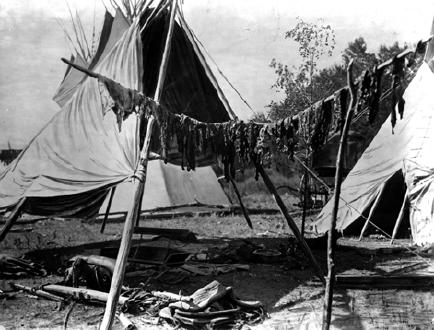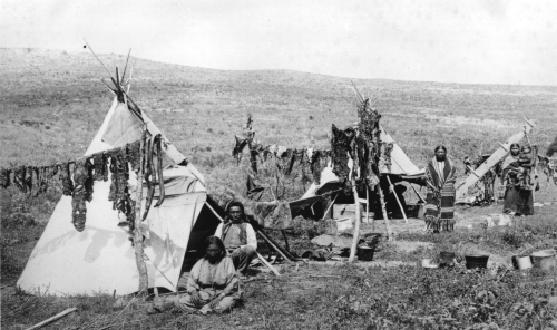Food
What do these photos tell you about the food that these people ate?
American Bison (Buffalo)
This is a bison or American buffalo. Millions of bison once lived on the Great Plains of North America. In the 1800s, they were the largest animal native to North America. An average buffalo cow provided about 400 pounds of meat. That was enough meat to feed one person for at least 200 days.

Photo: Colorado Historical Society
More About This Topic
The bison lived on the blue grama and buffalo grass that grew on the plains. During the summer, when there was a lot of grass, the buffalo grazed in large herds. Some herds had several thousand animals. That was the best hunting season for the Plains Indians. The bison broke up into smaller herds during the winter, when there was less grass to eat.
Their Own Words
"From the top of Pawnee Rock, I could see from six to ten miles in almost every direction. The whole mass was covered with buffalo, looking at a distance like one compact mass....I have seen such sights a number of times, but never on so large a scale."
Source: Colonel Richard Irving Dodge, May 1871, quoted in Donald Berthrong, The Southern Cheyenne (Norman, OK: University of Oklahoma Press, 1963, p. 31.
Drying Buffalo Meat
The pole in this photo holds strips of bison or buffalo meat that are drying in the sun. Removing the moisture kept the meat from spoiling. Dried meat could be kept for several months.

Photo: Colorado Historical Society
More About This Topic
During the summer, Indians dried meat to provide food during the winter. Summer was the best hunting season. Then the buffalo roamed the plains in large herds. They broke up into small herds during the winter and were more difficult to find.
Their Own Words
"It took our women only a short time to cut up a buffalo. . . , using the wide knives they carried hung from their belts. The brains and the liver we ate raw. . . . The rest of the meat they cut into strips and hung from a pole set up between two forked sticks to dry."
Source: Althea Bass, The Arapaho Way: A Memoir of an Indian Boyhood [by Carl Sweezy] (New York: Clarkson N. Potter, Inc., 1966), p. 29.
Drying Pemmican
The poles in this photo are covered with strips of buffalo meat hanging to dry and with pemmican. Pemmican is dried meat that was ground up, flavored and stuffed into buffalo intestines. Two lengths of pemmican are hanging from the end of the pole on the left.

Photo: Colorado Historical Society
More About This Topic
Indians in Colorado also used buffalo meat to make pemmican. They made it by roasting dried meat, beating it into small pieces, then adding melted fat, bone marrow, and powdered dried wild cherries. This mixture was stuffed into intestine casings, much like sausage. Pemmican added variety to the Indians' meat diet.
Their Own Words
"Some of this [dried beef] they pounded and mixed with dried fruits and covered with melted tallow. This we called pemmican. It made a fine food, and we never went hungry when we had it."
Source: Althea Bass, The Arapaho Way: A Memoir of an Indian Boyhood [by Carl Sweezy] (New York: Clarkson N. Potter, Inc., 1966), p. 29.
Gathering Wild Turnips
This woman is holding wild turnips dug up on the plains. The turnips in her right hand are strung together on a cord. The bag in her left hand also is full of turnips. This photo was taken sometime after 1900, when the plains Indians lived on reservations. They still went out to harvest wild vegetables.

Photo: Denver Public Library, Western History Collection
More About This Topic
The plains Indians did not live only on buffalo meat. They also gathered grass seeds and wild vegetables. The vegetables gathered on the plains included prairie turnips, Jerusalem artichokes, and Indian potatoes. The Ute Indians who spent part of each year in the mountains, also gathered berries, nuts, and acorns from the forests.
Their Own Words
"Women and children are employed in gathering grasshoppers, crickets, ants, and various other insects, which are carefully preserved for food, together with roots, and grass seed. From the mountains they bring the nuts which are found in the cones of the pine, acorns from dwarf oaks, different kinds of berries, and the inner bark of the pine, which has a sweet acid taste, not unlike lemon syrup."
Source: Warren Angus Ferris, Life in the Rocky Mountains (Denver: The Old West Publishing Co., 1940), p.?? [from Pettit, The Utes, 12].

